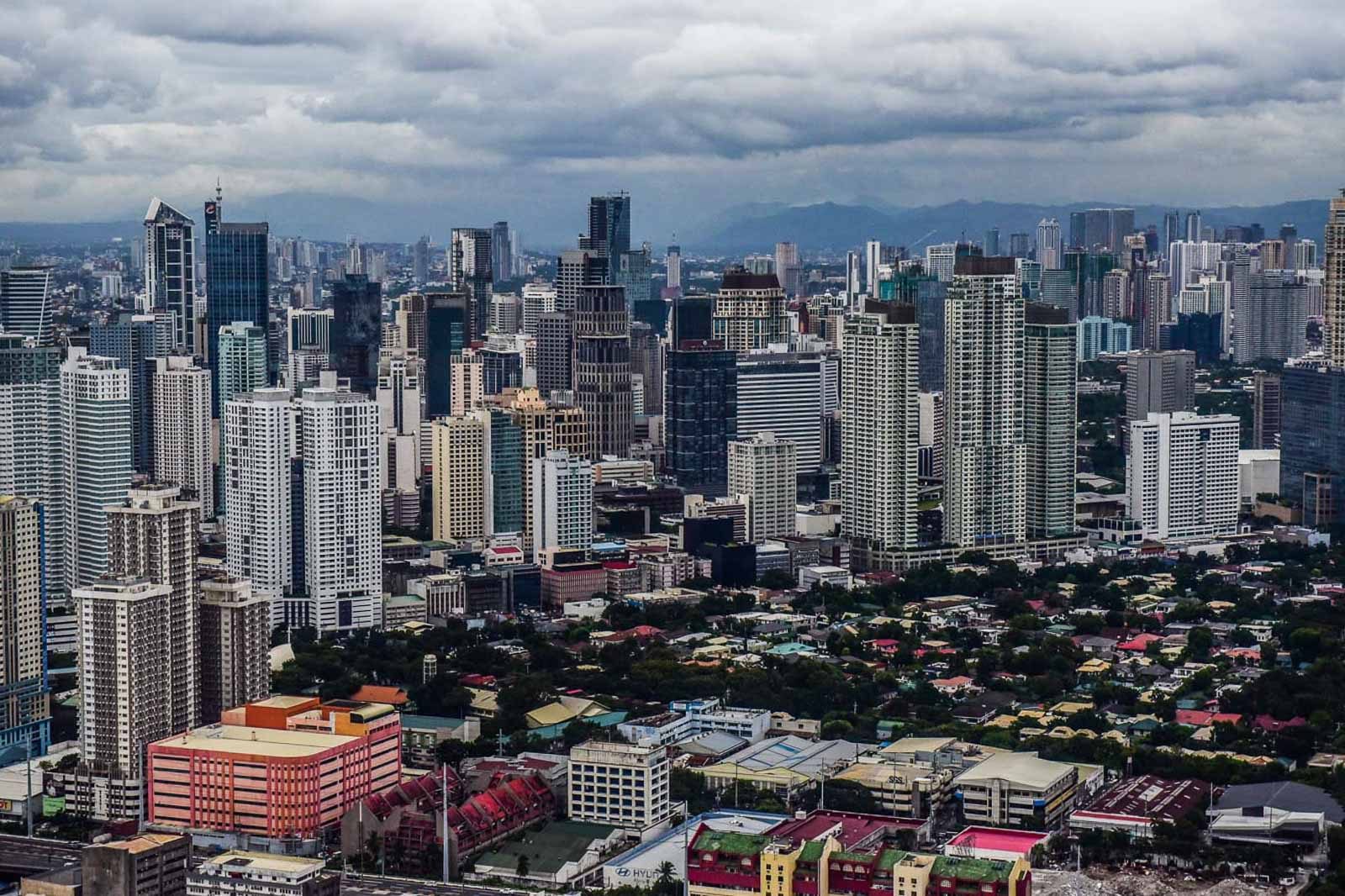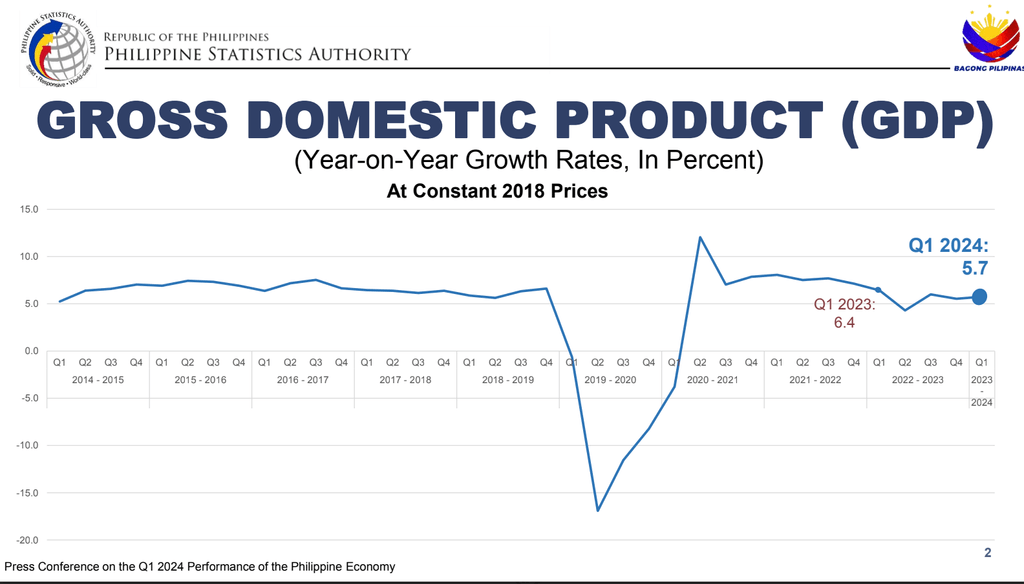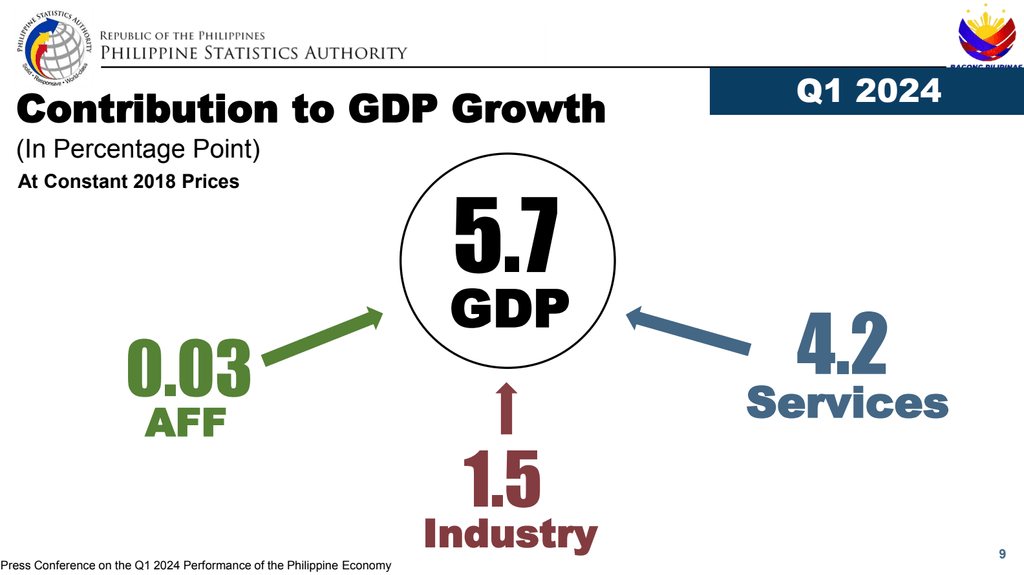SUMMARY
This is AI generated summarization, which may have errors. For context, always refer to the full article.

MANILA, Philippines – The Philippine economy grew at a faster pace in the first quarter of 2024 compared to the previous three-month period despite elevated inflation and interest rates, but the growth was below expectations.
The Philippine Statistics Authority on Thursday, May 9, reported that the gross domestic product (GDP) grew by 5.7% in January-March 2024, higher than the revised 5.5% figure reported for the fourth quarter of 2023.
The latest figure, however, is lower than the 6.4% expansion posted in the first quarter of 2023.

GDP growth also fell short of expectations, as economists and analysts polled by BusinessWorld earlier estimated it would hit 5.9%.
Government economic managers aim for full-year growth to settle between 6% and 7%.

Agriculture, forestry, and fishing grew by 0.4%, while industry and services posted gains of 5.1% and 6.9%, respectively.
Per industry, accommodation and food services (13.9%) and finance and insurance activities (10%) posted double-digit gains.

Caution
National Economic and Development Authority (NEDA) Secretary Arsenio Balisacan said the Philippines retained its position as a “leading force among Asia’s emerging economies.”
“Our first quarter GDP growth rate is about the same as Vietnam’s, surpassing other major economies such as China at 5.3%, Indonesia at 5.1%, and Malaysia at 3.9%, but slower than India’s projected growth rate of 6.2%,” Balisacan said.
While the Philippines posted stronger growth than its regional peers, Balisacan said moderate growth in domestic demand amid high inflation, which “reflected the less favorable business sentiment,” must be acknowledged.
“Construction slowed down, no doubt affected by prolonged periods of extreme heat. Household spending also slowed due to elevated prices of major food items and the heat wave,” Balisacan said.
According to National Statistician Dennis Mapa, household consumption was weakest since 2010.
Balisacan said the government continues to “alleviate the impact of El Niño while preparing for La Niña.” Effects of the weakening El Niño persist in the country, while La Niña has a 60% chance of developing in the June-August period.
“We are collaborating with distribution utilities to manage the increasing electricity demand and working with private water concessionaires to address leaks and wastage, ensuring water security,” the NEDA secretary added.
Government spending also slowed down, which Balisacan attributed to “the sliding of a large amount of expenditure to April.” – Rappler.com
1 comment
How does this make you feel?
![[EDITORIAL] Apat na taon na lang Ginoong Marcos, ‘di na puwede ang papetiks-petiks](https://www.rappler.com/tachyon/2024/07/animated-bongbong-marcos-2024-sona-day-carousel.jpg?resize=257%2C257&crop=280px%2C0px%2C720px%2C720px)
![[In This Economy] Delulunomics: Kailan magiging upper-middle income country ang Pilipinas?](https://www.rappler.com/tachyon/2024/07/in-this-economy-upper-middle-income-country.jpg?resize=257%2C257&crop=421px%2C0px%2C1080px%2C1080px)

![[EDITORIAL] Marcos Year 2: Hilong-talilong](https://www.rappler.com/tachyon/2024/07/animated-bongbong-marcos-2nd-sona-carousel.jpg?resize=257%2C257&crop=136px%2C0px%2C720px%2C720px)
![[Newspoint] A fighting presence](https://www.rappler.com/tachyon/2024/07/thought-leaders-a-fighting-presence.jpg?resize=257%2C257&crop=441px%2C0px%2C1080px%2C1080px)
The Government once again focuses solely on GDP without considering how it affects poverty, income, employment, equity, and government debt. This raises the question of whether the Government is hiding something or some things behind this figure, as it appears to give little importance to the relationship between GDP and these crucial factors.